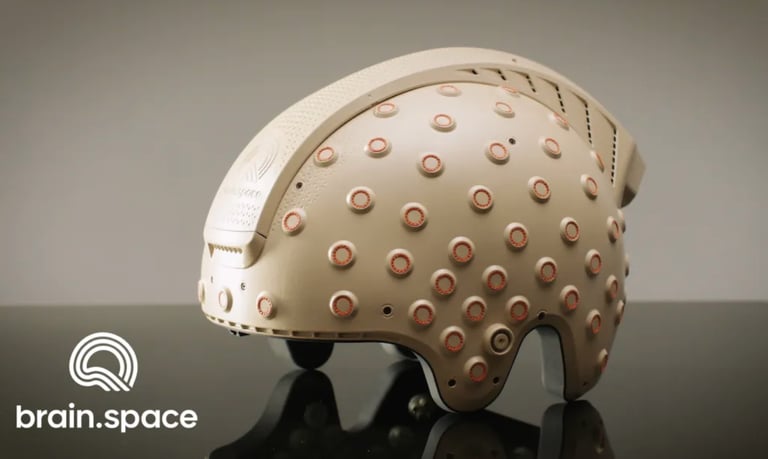From Thought to Action: Understanding Brain-Computer Interfaces
TECHNOLOGY
Neil Shaw
8/1/20254 min read
Introduction
Imagine being able to play a video game, write an email, or move an object using only your thoughts. At first, this sounds like something out of a science fiction movie, but it’s real. The technology that makes these seemingly supernatural tasks possible is called a Brain-Computer Interface (BCI).
What Is a Brain-Computer Interface?
In simple terms, a BCI is a system that allows the brain to communicate directly with a device. Instead of pressing keys or moving a mouse, a BCI translates your brain’s electrical activity into digital commands. This innovation is especially life-changing for people who cannot move or speak. With a BCI, someone who is paralyzed could write messages, operate a wheelchair, or even feed themselves.
How BCIs Work
The process starts with the brain. Every time you think, neurons send out tiny electrical signals. A BCI captures these signals with sensors, filters out noise, and uses algorithms to interpret your intent. Once decoded, the system sends the corresponding command to a device, which then performs the action. Finally, the user receives feedback—such as watching a cursor move on a screen—which helps them refine their control over time.
A Brief History of BCIs
The story of BCIs stretches back further than most people realize. In the 1920s, a German psychiatrist named Hans Berger became fascinated with the brain’s electrical activity. In 1924, he successfully recorded the first electroencephalogram, or EEG, which measures brain waves. His early methods were invasive, involving wires inserted under the scalp, but they worked. Berger’s work proved that brain signals could be measured, laying the groundwork for decades of research to come.
Early Breakthroughs
Decades later, in 1973, computer scientist Jacques Vidal introduced the term “brain-computer interface.” He demonstrated that EEG signals could be used to detect attention and intention, predicting a future where we could control machines with our minds. Just a few years later, in 1977, Vidal created a system that allowed a person to guide a cursor through a maze using only brain signals—the first true demonstration of a working BCI.
Rapid Progress in the Field
From there, progress accelerated rapidly. In 1988, researchers at South Carolina State University achieved a breakthrough when they used EEG signals to control a robot—marking the first time a machine responded directly to brain activity. By 2008, BCIs advanced to the point where a monkey used one to move a robotic arm and feed itself. Two years later, more than 700,000 people were using cochlear implants, a type of BCI that restores hearing. In 2013, DARPA—the U.S. military’s research agency—invested heavily in next-generation, non-surgical BCIs.
Video 1. This video showcases the experiment where a monkey used a BCI to feed itself.
The BCI Workflow
Modern BCIs operate through a series of critical steps. First, neurons fire and produce electrical signals, which are captured by sensors—either non-invasive ones placed on the scalp or implanted electrodes inside the brain. The signals are then processed to remove noise like eye blinks or muscle activity. Next, machine learning algorithms translate the brain patterns into commands sent to an external device, such as a robotic arm or computer cursor. Finally, feedback loops allow users to refine their mental control. Each step is essential, and even small errors can cause the system to fail.
Applications in Medicine and Beyond
Right now, BCIs are making the biggest difference in medicine. For individuals who have lost the ability to move or speak, these systems can restore independence. Stroke patients can use BCIs during therapy to retrain their brains. People with spinal cord injuries can control wheelchairs or robotic arms. For amputees, BCIs power neuroprosthetics—robotic limbs that move naturally and, in some cases, provide sensory feedback. BCIs can even give people with “locked-in” syndrome the ability to communicate again by typing with their thoughts. Beyond healthcare, researchers are exploring BCIs in gaming, education, and even military operations.
Challenges and Ethical Concerns
However, the rise of BCIs brings serious concerns. One major issue is privacy: neural data can reveal thoughts, emotions, and reactions. If hacked or sold, this data could expose a person’s innermost mind. Currently, there are no clear laws protecting brain data. Another challenge is fairness. BCIs are expensive and mostly limited to wealthy individuals or research institutions. If these devices become common in education or work, people who cannot afford them could be left behind, creating a “neuro-elite.” Regulatory gaps pose another problem since BCIs do not fit neatly into existing laws. As non-medical uses like gaming or military tech expand, strong global standards will be essential to ensure safety and ethics.
Looking Ahead
The future of BCIs is both exciting and uncertain. Researchers are working on wireless implants, smaller sensors, and smarter AI to make BCIs easier to use and more accurate. Costs are dropping, and new applications emerge every year. Some experts believe BCIs could eventually become as common as smartphones. But to ensure these technologies benefit everyone, we need robust ethical guidelines, clear regulations, and a strong commitment to mental privacy. Brain-computer interfaces are no longer science fiction—they are real, powerful, and transforming lives. The only question now is how we choose to use them.
Image 1. This image shows a modern EEG developed by brain.space.
References
Berger, H. (1929). Über das Elektrenkephalogramm des Menschen. Archiv für Psychiatrie und Nervenkrankheiten.
Vidal, J. J. (1973). Toward direct brain-computer communication. Annual Review of Biophysics and Bioengineering.
Lebedev, M. A., & Nicolelis, M. A. (2006). Brain–machine interfaces: past, present and future. Trends in Neurosciences.
Mak, J. N., & Wolpaw, J. R. (2009). Clinical applications of brain-computer interfaces: current state and future prospects. IEEE Reviews in Biomedical Engineering.
Donoghue, J. P. (2008). Bridging the brain to the world: a perspective on neural interface systems. Neuron.
DARPA (2013). Next-generation non-invasive neurotechnology. www.darpa.mil
National Institute on Deafness and Other Communication Disorders (NIDCD). Cochlear Implants. www.nidcd.nih.gov
Lenca, M., & Andorno, R. (2017). Towards new human rights in the age of neuroscience and neurotechnology. Life Sciences, Society and Policy.
New Scientist. (2008, May 28). Robo‑monkeys use brain power to grab a bite. New Scientist. Retrieved from New Scientist dn14000 article



Join Us
Inspiring learners to innovate through technology and mentorship.
CONNECT with US
stay in touch with us
info@nexusquest.org
NQ nexusquest.org is an IRS certified 501(c)(3) Nonprofit Organization | EIN# 33-3647471
©2025 All rights reserved
